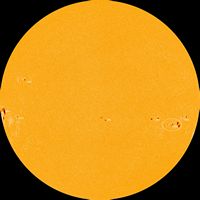The sun ushered out 2013 and welcomed 2014 with two mid-level flares on Dec. 31, 2013 and Jan. 1, 2014. Solar flares are powerful bursts of radiation. Harmful radiation from a flare cannot pass through Earth's atmosphere to physically affect humans on the ground, however -- when intense enough -- they can disturb the atmosphere in the layer where GPS and communications signals travel. This disrupts the radio signals for as long as the flare is ongoing, anywhere from minutes to hours.



To see how this event may impact Earth, please visit NOAA's Space Weather Prediction Center at http://spaceweather.gov, the U.S. government's official source for space weather forecasts, alerts, watches and warnings.
The first flare (below) was categorized as an M6.4 and it peaked at 4:58 p.m EST on Dec. 31. The second (above) was categorized as an M9.9 and peaked at 1:52 p.m. EST on Jan. 1. Both flares emerged from the same active region on the sun, AR1936.
Imagery of the flares was captured by NASA's Solar Dynamics Observatory, which keeps a constant watch on the sun, collecting new data every 12 seconds.
For a little more insight into the project see this:http://www.nasa.gov/content/goddard/two-solar-flares-say-goodbye-2013-and-welcome-2014/
